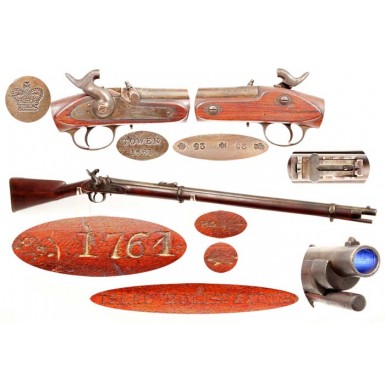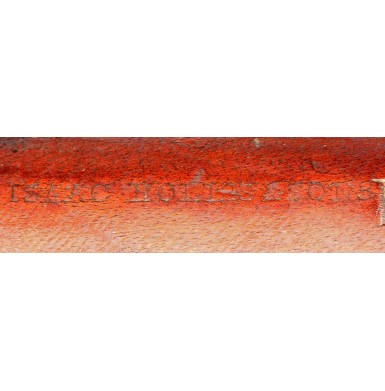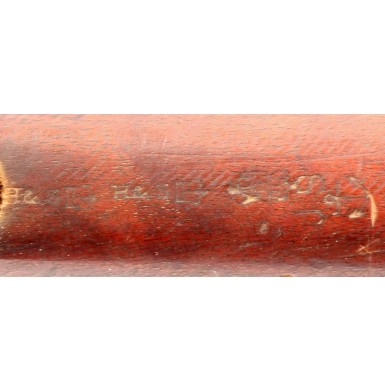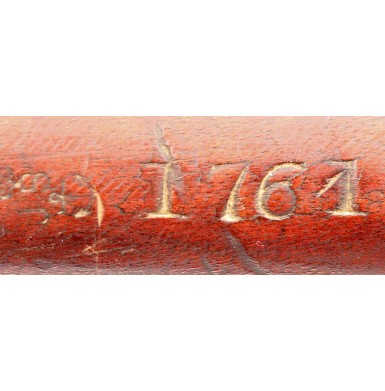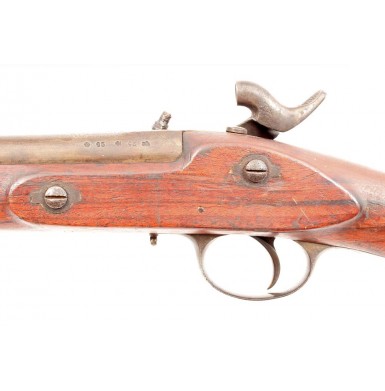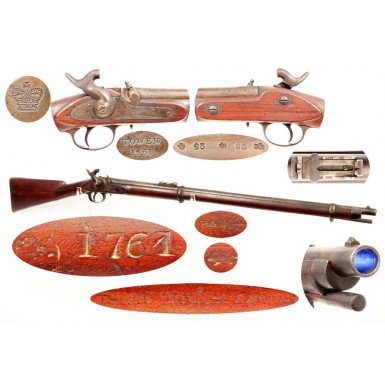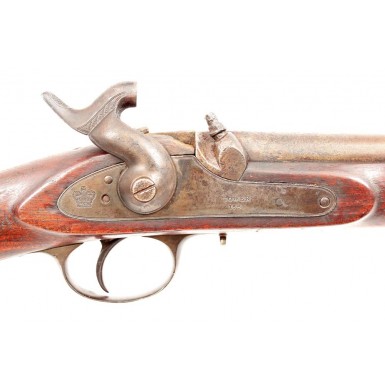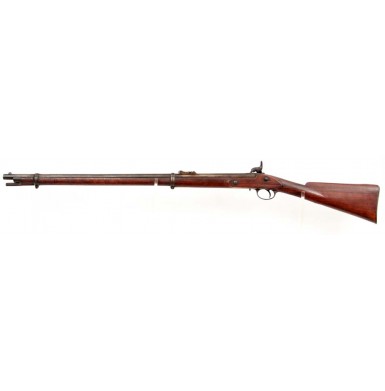Confederate Numbered Bar On Band Enfield Rifle
- Product Code: FLA-2870-SOLD
- Availability: Out Of Stock
-
$1.00
This is a well-used example of a rarely encountered Confederate imported British Pattern1856 No 2 Iron Mounted Bar on Band Short Rifle. These rifles are also sometimes referred to as P-1858 Rifles, but this is can be confused with the P-1858 Naval Rifle, so I prefer the “No 2” designation. The gun bears the highly desirable Confederate J S / (ANCHOR) viewer’s mark behind the triggerguard, and has the Confederate inventory number 1761 stamped in the wood of the belly of the stock. During 1861 and 1862, the Confederacy let a number of contracts for the delivery of “Enfield” pattern percussion long arms of all varieties. Many of these contracts are well documented in the papers of Confederate General Colin McRae, which reside in the collection of the South Carolina Relic Room & Military Museum, in Columbia, SC. While the majority of the purchases concentrated on P-1853 Enfield rifle muskets for use by Confederate the infantry, a number of “short rifles’ and carbines (both artillery and cavalry) were obtained as well. Confederate documents reveal that one of the early orders included 30,000 P-1853 “Long Enfields’ (obtained from Sinclair, Hamilton & Company), as well as 10,000 “short rifles’ of varying patterns. The 40,000 guns from these Confederate central government contracts are the ones that are found with the both the J S / (ANCHOR) viewer’s mark and Confederate inventory number markings. The “Long Enfields’ were serialized in three series, from 1-10,000, 1-10,000 A and 1-10,000 B (although no gun bearing “10,000” has ever been encountered). The short rifles were simply serialized 1-10,000, without series letters. The short rifles were a mixture of standard P-1856 and P-1856 Type No2 (also known as the P-1858 “Bar on Band”) iron mounted rifles, as well as non-standard brass mounted P-1856 and P-1856 No2 rifles. A handful of the brass mounted P-1858 Naval Rifles, and iron mounted P-1860 and P-1861 rifles were also purchased. . Of those patterns and variants, the iron mounted “Bar on Band” rifle is the scarcest, with less than 5 known examples extant with the JS / (Anchor) marking and Confederate inventory numbers. It is interesting to note that the brass mounted “Bar on Band” rifle (which was not a standard British military pattern, but rather a “volunteer” or commercial pattern rifle) is encountered with Confederate markings at nearly twice the rate of the iron mounted version. The British Pattern 1856 No 2 rifle (aka Pattern 1858) was adopted by the British military in 1858 as a modification to the P-1856 rifle, which provided additional support for the saber bayonet. The gun is stocked to within 1 ““ of the muzzle and the saber bayonet lug was relocated to the upper barrel band from the barrel itself. The upper band was secured to the stock by a thick transverse pin, which helped support the weight of the heavy saber bayonet. This particular design was short lived, and with the adoption of the heavier barreled Pattern 1860 “short rifle”, the British military essentially eliminated the use of this pattern. However, the variant remained in use with volunteer units and was still manufactured for commercial sale. The P-1858 Bar on Band rifle was in all other ways essentially the same as the P-1856 rifle, with a 33”, .577 caliber barrel, which was rifled with three groove, progressive depth rifling. The standard military version was mounted with iron furniture, and had the rear most sling swivel attached to the toe of the stock via a screw in mount. The brass mounted version of the rifle (which was not a British military pattern) had the rear swivel mounted to the front bow of the triggerguard, as on the P-1858 Naval Rifle. The “Bar on Band” rifle was equipped with the same pattern rear sight found on the P-1856 rifle, which was graduated to 1,100 yards. The P-1856 No 2 iron mounted rifles had blued barrels and color case hardened locks and hammers. The furniture (triggerguard, butt plate, stock escutcheons, nose cap, etc.) of the “iron mounted” rifles was made of iron rather than brass, and was color casehardened as well. Due to the difficulty of engraving a number in the case hardened buttplate tang (versus the much softer brass used on brass mounted guns), the iron mounted rifles that were inventory numbered were marked with their number in the wood of the stock belly, between the triggerguard and buttplate. The various Enfield pattern “short rifles’ were lighter and handier than rifle muskets and were preferred for use not only by Confederate infantry that functioned as skirmishers and sharpshooters, but by Confederate cavalry that tended to operate as mounted infantry, rather than as traditional heavy cavalry. Confederate cavalry commanders J.E.B. Stuart and Nathan Bedford Forrest were both proponents of issuing short rifles to their cavalry troopers. Short rifles with saber bayonets are known to have been issued to Confederate infantry regiments serving in Kershaw’s South Carolina Brigade, the 10th, 16th, 18th & 51st Georgia, the 13th, 17th, 18th & 51st Mississippi, the 41st Tennessee, the 1st Battalion of Texas Sharpshooters, and the 5th Texas. Mounted Confederate units that are known to have been issued the “short Enfield rifle” were Cobb’s & Phillip’s Legions of Georgia, the 18th & 19th Mississippi cavalry (McCulloch’s Brigade of Forrest’s 2nd Cavalry), the 2nd North Carolina cavalry, the 3rd, 6th, 9th & 27th Texas cavalry (Ross’ brigade) and the 7th Virginia cavalry. Today, a multi-decade survey of extant surviving Confederate marked and inventory numbered short rifles reveals that less than 100 of these guns have survived (about 1% of the total purchased). While some are in private collections, others reside in museum or other public collections where they can be viewed, but never owned by a collector.
As previously noted, less than 5 iron mounted, JS/Anchor and inventory numbered Pattern 1856 No 2 Bar On Band Iron Mounted Short Rifles are known to exist today. In fact, Confederate marked examples of this pattern of long gun are extremely rare. The belly of the stock bears a crisp and clear JS / (ANCHOR) mark behind the triggerguard, as well as the stamped Confederate inventory number 1761. The toe of the stock is crisply stamped ISAAC HOLLIS & SONS, the company that manufactured the rifle in Birmingham, England. The rifle is marked not only with the company name in the toe of the stock, but with the company’s makers mark, a (CROWN) / H&S, stamped twice behind the triggerguard. There is also a small Birmingham Small Arms Trade mark in the wood behind the triggerguard, a (CROWN) / B / S T / A, which is partially obscured by the Confederate marks that over stamp the BSAT mark. During the Civil War era, Isaac Hollis & Sons was located at 5-11 Weaman Row in Birmingham. The firm had originally been established as a family partnership 1814 (according to Isaac Hollis & Sons advertisements), and in 1848 evolved into a partnership with Isaac Sheath, forming the firm of Hollis & Sheath. In 1861 the partnership between Isaac Hollis and Isaac Sheath ended with Sheath’s retirement and the firm became Isaac Hollis & Sons. The firm remained in business through 1900, and during that time was one of the largest and premier gunmakers of the Birmingham trade. They were a founding and influential member of the Birmingham Small Arms Trade association, and major stockholders in the Birmingham Small Arms Company (BSA).
This Confederate purchased P-1856 No 2 Iron Mounted Bar on Band Rifle is in about GOOD+ condition and is relatively fresh to the market, coming from an old Louisiana collection. The rifle is well used and shows some interesting period modifications, but is absolutely a genuine example of a very scarce, Confederate purchased, marked and numbered “Bar on Band” short rifle. The gun has clearly seen significant service in the field, and probably saw significant post war service as well as a hunting rifle. In all reality, the rifle was probably the most valuable possession of the man who brought it home at the end of the war. Today, the rifle is missing the bayonet lug from the upper barrel band, the original ramrod, both sling swivels, the snap cap (cone protector) and the upper barrel band screw retaining “doughnut”. Although this seems like a long list, the small parts are often missing from Confederate rifles. Sling swivels and snap caps in particular tend to be missing from CS used Enfields that saw any real service, and rarely do Confederate numbered guns retain their original numbered ramrods. It is also fairly common for the saber bayonet lug from a numbered Confederate Enfield to be missing. I believe that it would not take many days of marching for the average southern solider to break the lug off the gun, giving him the excuse that he no longer needed to carry the 2 pound saber bayonet as he had no lug to attach it to! As previously noted, the gun bears the expected the JS / (ANCHOR) viewer’s mark behind the triggerguard and has the Confederate inventory number 1761 stamped in the stock. The lock plate of the rifle is crisply and clearly marked with the typical English (CROWN) (without a “VR”) to the rear of the hammer and TOWER / 1861 forward of the hammer. The lock functions well on all positions, and is mechanically sound. The hammer is a little loose on the tumbler, indicating lots of use and some wear between these two parts, but the hammer is assembly numbered to the lock, so it is not a replacement. The interior of the lock bears only the number 1 on the lock plate and on the interior neck of the hammer. The top edge of the lock plate has the traces of the assembly mating mark \ / | |, but it is mostly obscured by some oxidation along the upper edge of the lock. The lock is mostly smooth, with a medium brownish-gray patina and some minor areas of scattered light peppering and minor pinpricking. Both of the lock mounting screws have the same mating mark, \ / | | chiseled on their necks. This same mark appears on the neck of the barrel tang screw and in the ramrod channel of the stock. The barrel of the rifle is clearly marked with typical Birmingham commercial provisional proof, view and definitive proof marks, as well as a pair of 25 gauge marks, indicating .577 caliber. The barrel is mostly smooth metal forward of the rear barrel band, with some scattered pinpricking and light peppering from the sight forward along its entire length. There is some light to moderate pitting present around the breech and bolster area, extending towards the rear barrel band, and some similar pitting around the muzzle of the rifle. The barrel has the same sort of splotchy gray-brown patina as found on the lock and furniture of the rifle, and suggests the rifle was probably cleaned a long time ago (likely more than 50 years or so). The bore of the rifle retains the original and correct pattern 3-groove rifling, and rates about GOOD+ to NEAR VERY GOOD. The rifling remains fairly crisp, but the bore is somewhat dirty and shows light to moderate pitting along its entire length, with a few smaller patches of more serious pitting present as well. A good scrubbing with a bronze brush would likely improve the bore. The underside of the barrel is marked BEASLEY BROS, the barrel maker, as well as ISAAC HOLLIS & SONS. The initials RC and JR are also present, and both the barrel and the breech plug are marked with the mating number 381. A small 7, which matches the Roman numeral “VII” that appears on the other major parts of the gun, is stamped under the bolster, below the stock line. The interior of the stock channel is also stamped with the number 381 and the initials H & S. The percussion cone (nipple) is an old, period of use replacement that is only partially seated in the bolster, and shows some battering and significant wear from use. The gun retains its original 1,100-yard rear sight, which is often missing from Confederate short rifles. The original front sight is in place near the muzzle. The original bayonet lug has been filed off the rifle, and only the flattened shadow of its base remains on the upper barrel band. It was not uncommon for the lugs of rifles that mounted heavy saber bayonets to break during service. It is equally likely that a disgruntled soldier who was tired of carrying the heavy and bulky saber bayonet broke the lug himself so he could reasonably discard the bayonet. The loss is almost certainly from the period of use, as the patina of the flattened portion of the barrel band, where the lug once was, matches the balance of the gun. The lower sling swivel missing from the rear of the rifle’s iron triggerguard tang, and the screw hole has been filled with an old screw. The upper swivel is missing from the upper barrel band of the gun as well. The lower barrel band tension screw retains its screw protecting doughnut, but the upper band is missing this small disc. The iron furniture has the same grayish-brown patina as found on the balance of the rifle, and matches barrel and the lock well. The ramrod in the channel under the stock is an old wooden replacement that shows years of real use and lots of age. The stock of the rifle rates about GOOD+ to NEAR VERY GOOD as well. The stock is full-length, but has been slightly modified by the man who carried the rifle, either during or after the war. While it is difficult to see in the photos, the forend of the rifle had been slimmed between the two barrel bands, to make the rifle slightly lighter and handier. Additionally, the buttstock has been re-profiled to give the comb a more angular look and to make the stock profile slightly sharper. The wood does not appear to have been altered around the lock area or the flat opposite the lock, nor was the wood along the belly and toe of the stock disturbed. Thankfully this has allowed the Confederate markings to remain crisp and legible. The modifications to the stock were simply the work of a man who was personalizing his rifle to his own likes, and making it more comfortable and esthetically pleasing to him. The work is very well done, and clearly, the man who did it had some significant skills as a woodworker. Whether these minor stock modifications were done during the war, or in the years after when the rifle provide a family with protection and food, is hard to know. The stock does have repaired crack in the forend that runs diagonally through the wood grain from about the middle of the right side of the forend towards the upper barrel band on the left side. The crack is not visible on the right (display) side of the rifle, but is on the. The crack shows a very old glue repair, which is only obvious with the barrel removed from the stock. There is also an old, surface grain drying crack present on the right side of the buttstock, near the toe. This is stable and tight, and only appears to go a couple of layers into the wood, and is non-structural. The stock also shows a number of bumps, dings and impact marks from actual use and service in the field. Considering that the gun arrived in the Confederacy no later than early 1862, probably fought through the whole war and continued to be used afterwards, it is really in pretty decent shape.
Overall this is a nice, if well used, example of a scarce Confederate marked and numbered P-1856 No 2 Bar on Band Short Rifle. With only 10,000 numbered short rifles having been purchased by the Confederacy for the Army (the CS Navy purchased an additional 1,000 numbered Naval Rifles as well), these guns are hardly common. In fact, a database that has recorded extant Confederate numbered rifles that have been inspected over the last 2-3 decades reveals that less than 100 of those 10,000 guns have survived, a survival rate of only 1%. Interestingly, only two numbers have been documented above the 17XX range. The other example is in the collection of the Virginia Historical Society and is also a “Bar on Band” rifle, but it is the more commonly encountered brass mounted variety. More than likely, that rifle is from the collection of pioneering Civil War arms collector and author Richard Steuart who co-authored Firearms of the Confederacy with Claude Fuller. Overall this is a solid example that clearly fought the majority of the war, and has survived in mostly complete and functional condition, if missing a couple of its original parts. Any serious collection of CS imported long arms needs at least one Confederate numbered short rifle to complete it, and this is a good opportunity to obtain a reasonably priced example that is completely authentic and correct.
SOLD
